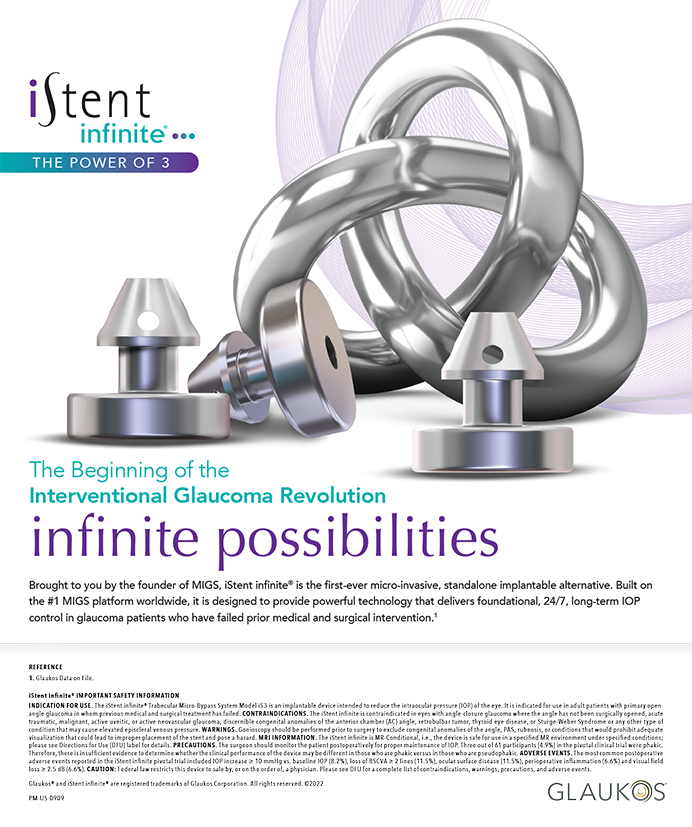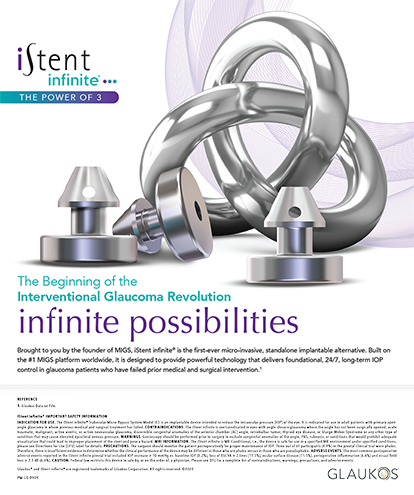The motivation for this article is to explain why surgeons such as myself are using the VisuMax femtosecond laser (Carl Zeiss Meditec, Inc., Dublin, CA). I believe that surgeons do not change technological paths based upon their success but rather their incidence of complications or rates of poor outcomes. If success were the key, I never would have switched to a femtosecond laser platform in the first place. Mechanical keratomes are what helped create the LASIK phenomenon, and I owe my refractive career to the results I obtained with them. Even today, I have cases that are more appropriately completed with a microkeratome, such as eyes with preexisting RK incisions and LASIK after an intracorneal ring segment's removal.
GROUNDS FOR ADOPTION
One factor in my choice of the VisuMax is that it can accurately prepare a planar lamellar flap for the LASIK procedure. Other reasons include the laser's utility for therapeutic techniques such as penetrating keratoplasty, deep anterior lamellar keratoplasty and Descemet's stripping automated endothelial keratoplasty, and all femtosecond refractive procedures. The last is what sealed the deal for me.
Integrating the VisuMax with the MEL 80 excimer laser (Carl Zeiss Meditec, Inc.) made sense in terms of ergonomics and symbiosis. The surgical staff can enter data into either computer system, and they are automatically sent to the other, thus avoiding the need for doubled entry. The time saved can be significant.
ACCURACY
Compared with other femtosecond laser systems, the VisuMax has several technical differences that, in my experience, result in the much more precise dissection of tissue. The process of docking the patient interface to the cornea differs from that with any other system. Other available platforms have a Hessberg-Barron–style, spring-loaded, syringe suction ring that rests on the perilimbal conjunctiva and sclera just anterior to the rectus muscle insertions. Docking a flat applanation lens to compress the corneal tissue and establish a reference plane for the spots' placement within the cornea follows the positioning of the suction ring. With the VisuMax, the patient interface is curved and docks directly to the limbal cornea. The system is not a two-piece design. The system's suction is incorporated into its curved lens/patient interface. As such, the suction and docking are a single step, which saves time over a two-step process. Additionally, although the VisuMax uses a curved lens interface, the vacuum level of 35 to 50 mm Hg attained for the docking is approximately one-third that of other systems. At this vacuum pressure, the central retinal artery is able to perfuse, so the patient can see the fixation light throughout the entire procedure.
MINIMUM APPLANATION AND CORNEAL STROMAL WRINKLING
The curved interface avoids applanation of the cornea and thus minimizes folds within the corneal stroma. Stromal folds are not a major obstacle if one is only creating flaps, but they are a huge negative in a stand-alone procedure such as femtosecond lenticule extraction (FLEX), developed by Carl Zeiss. During the FLEX procedure, the VisuMax makes a posterior and an anterior layer of spots in the shape of the tissue that needs to be removed to correct the refractive error. The surgeon creates a 270° side cut to form a traditional flap, which he lifts, and then peels the lenticule off the stromal bed.
Another technique in development is small-incision lenticule extraction (SMILE). For SMILE, the surgeon enters the same parameters for the lenticule as with FLEX but does not create a 270° side cut. Instead, he makes a 2-clock hour side cut and removes the lenticule through it. To clarify, neither the FLEX nor SMILE procedure uses excimer laser photoablation. The refractive change is completed by the removal of the lenticule created by the femtosecond laser.
LASER ENERGY
The laser energy settings of the VisuMax are also unique. My colleagues and I currently use an out-to-in spiral pattern. Photodisruption does not create an opaque central layer of bubbles, so we do not have to make a side pocket; we can proceed directly to excimer laser ablation.
A key feature of the VisuMax is the high numerical aperture of the optical system. Precisely focusing light is elemental for the application of any photodisruptive laser, and a high numerical aperture will optimize performance. With the latter, one can achieve the most accurate Z-axis spot placement and the smallest-diameter spot. Less pulse energy is therefore needed, and refractive precision becomes optimal. With the VisuMax, the precision of the spots' serial placement and the resultant flap thickness with the VisuMax are in the low single-digit first standard deviation, which is markedly more precise than with other commercially available systems.1,2 This accuracy is critical to refractive and tissue-removing techniques in a stand-alone procedure. The energy per pulse of the VisuMax laser is 200 nJ at present, which is eight times less than the 1.6 µJ of other commercially available ophthalmic femtosecond lasers. The lower energy results in minimal-to-no tissue trauma and subsequent corneal inflammatory response.
CONCLUSION
My colleagues and I chose the VisuMax for the optical system's high numerical aperture and precise placement of laser spots. This technology allows us not only to create LASIK flaps but to work toward refractive procedures using only a femtosecond laser. The system is also suited to therapeutic corneal techniques, both lamellar and penetrating.
John F. Doane, MD, is in private practice with Discover Vision Centers in Kansas City, Missouri, and he is a clinical assistant professor for the Department of Ophthalmology, Kansas University Medical Center. He is a consultant to Carl Zeiss Meditec, Inc., and has been reimbursed for research overhead. Dr. Doane may be reached at (816) 478-1230; jdoane@discovervision.com.
- Reinstein DZ. Transitioning to femtosecond technology. Cataract & Refractive Surgery Today Europe. 2009;2:4(suppl):3-5.
- Reinstein DZ, Archer TJ. Assessment of VisuMax femtosecond laser accuracy and precision of flap thickness and centration. Poster presented at: The 2008 ASCRS Symposium on Cataract, IOL and Refractive Surgery; April 2008; Chicago, IL.


